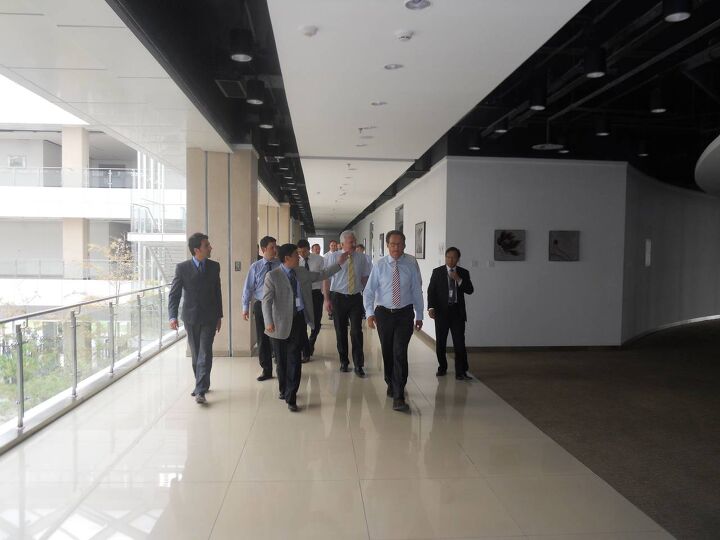Cutting Corners Helps China Make Better Cars

BMW visits CH-Auto
History tends to repeat itself – in different ways. One of the secrets of Japanese quality was a shortage of money. Bad quality was seen as waste – known as the detested “muda” to scholars of Kaizen. Lines had to be made more flexible; re-tooling had to be made easier, all because there was no money to waste. Likewise, China is getting better at making cars. One reason: It’s getting better at cutting corners, says a report by Reuters.
The man who wrote it knows Japan and China well. Norihiko Shirouzu was the Wall Street Journal’s China correspondent, now he is the man on the Chinese car beat for Reuters. He says:
“Paring back on crash tests, skimping on frills, simplifying designs, using cheaper materials and, in a departure for the industry, outsourcing most of their design and engineering are having a profound effect on the cost bases of China’s dozens of car makers. Some are now able to sell cheap and cheerful small cars for about 40,000 yuan ($6,350) – less than half the price of a plain vanilla Toyota.”
The outsourcing part is totally different from what the Japanese did and still do. Eight out of ten cars sold by independent Chinese automakers are the handiwork of three independent design houses: CH-Auto, IAT Automobile Technology Co. of Beijing; and TJ Innova Engineering & Technology Co. of Shanghai.
CH-Auto is a legacy of failed Chrysler. The company was established in 2003 by a small group of jobless Chinese engineers who had trained with Beijing Jeep, a former joint venture between BAIC and American Motors, later Chrysler. According to the report ..
“CH-Auto and its rivals say they have moved beyond aping foreign designs. Instead of copying the shape of a component or an entire foreign car, they try to match its performance as well – often successfully – even as they improvise and simplify the original design to cut costs. The aim is to make cars affordable to China’s emerging middle class, people who are earning 50,000 to 60,000 yuan a year ($7,900-$9,500).”
The competition in Japan already is taking note. Says Shiro Nakamura, chief designer at Nissan:.
“This is a warning shot to the established engineers who have told their management time and time and again that this is the minimum cost they can achieve with their existing design and production methodology. Now the Chinese are saying they can cut another 30, 40 percent of the cost.”

Bertel Schmitt comes back to journalism after taking a 35 year break in advertising and marketing. He ran and owned advertising agencies in Duesseldorf, Germany, and New York City. Volkswagen A.G. was Bertel's most important corporate account. Schmitt's advertising and marketing career touched many corners of the industry with a special focus on automotive products and services. Since 2004, he lives in Japan and China with his wife <a href="http://www.tomokoandbertel.com"> Tomoko </a>. Bertel Schmitt is a founding board member of the <a href="http://www.offshoresuperseries.com"> Offshore Super Series </a>, an American offshore powerboat racing organization. He is co-owner of the racing team Typhoon.
More by Bertel Schmitt
Latest Car Reviews
Read moreLatest Product Reviews
Read moreRecent Comments
- Ajla My only experience with this final version of the Malibu was a lady in her 70s literally crying to me about having one as a loaner while her Equinox got its engine replaced under warranty. The problem was that she could not comfortably get in and out of it.
- CoastieLenn Back around 2009-2010, a friend of mine had a manual xB and we installed a Blitz supercharger kit. Was a really fun little unit after that.
- Ajla What is Chevrolet going to run in NASCAR? I get that there is basically no connection to street cars any longer but I still don't see them putting Blazer or Corvette stickers on their stuff.
- CKNSLS Sierra SLT Since they are the darling of the rental fleets I have probably spent about 5,000 miles in two different Malibus. I was ready to be discouraged. But for what they are-they are a competent riding vehicle and they get close to 40mpg cursing at a reasonable speed. A little too much plastic in the interior-making it look "cheap". But if I was looking for a competent sedan I would consider an off rental one at a decent price. A new one would suffer massive depreciation-probably.
- Arthur Dailey Kinda wish that I had bought one back in 2011. Yes I know that some here prefer the first generation to the second. But the first was not available new in Canada.I didn't appreciate the centre mounted instrument panel.However one of my children had one as a week long rental and much preferred it to the Prius that she had previously.


































Comments
Join the conversation
Are we missing something else here? The article states that a few design firms are supplying dozens of auto "manufacturers". This business idea alone might be saving some money.
This approach will never lead to cars acceptable in the US and Europe or Japan, for that matter. All impose heavy regulations designed to make cars safer and more efficient. And that entails heavy-duty engineering - hybrid system, lightweight structures, electronic intensive nannying devices. Outsourced super low cost engineering will never be able to compete in engineering demanding US and European markets. The Chinese are not miracle workers. Their economy looks miraculous, but it isn't. It's just a loosening on investment and reward. Not all that hard to do, the government just has to allow certain things. And they've regulated it so badly, they're riding for a fall. The Chinese economy will look significantly less miraculous in, oh, five years' time. And in ten, we'll all be wondering why we thought they were geniuses.